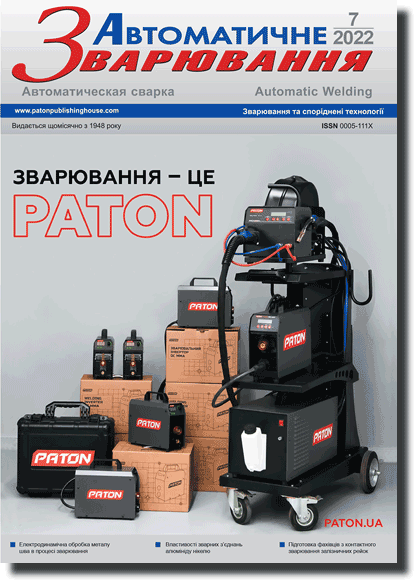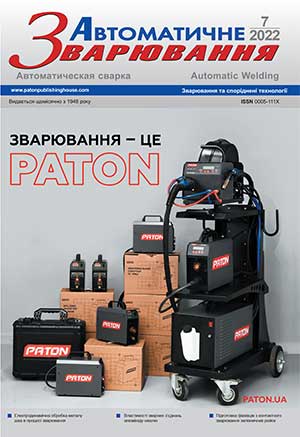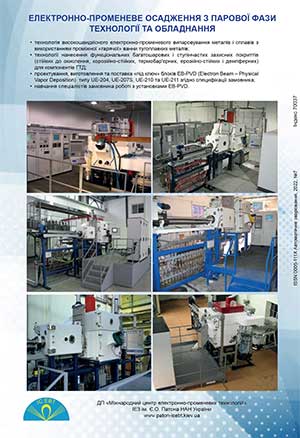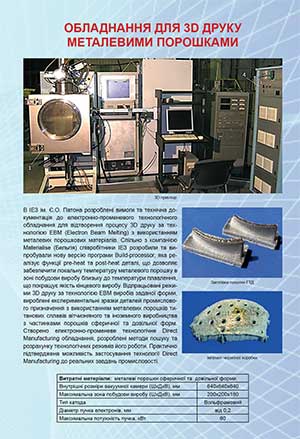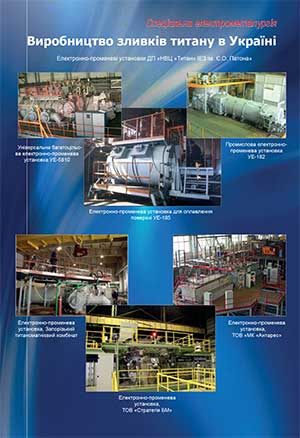| 2022 №07 (02) |
DOI of Article 10.37434/as2022.07.03 |
2022 №07 (04) |
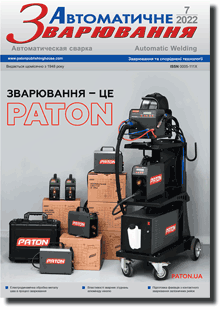
"Avtomatychne Zvaryuvannya" (Automatic Welding), #7, 2022, pp. 16-25
Corrosion-mechanical resistance of welded joints of AMg5M alloy produced in different spatial positions of butts
L.I. Nyrkova, S.O. Osadchuk, S.Yu. Kovalenko, L.V. Goncharenko, A.V. Klymenko
E.O. Paton Electric Welding Institute of the NAS of Ukraine. 11 Kazymyr Malevych Str., 03150, Kyiv, Ukraine. E-mail: office@paton.kiev.ua
The resistance to continuous corrosion of the base metal of АМg5М alloy of the Al–Mg alloying system was evaluated, the resistance groups were determined in the moving stream of 3% NaCl “resistant”, in a 3 % NaCl+0.1 % H2O2, neutral salt fog, periodic immersion in a 3 %- NaCl, under high humidity – “highly resistant”. Tests of welded joints produced in different spatial positions of the butts (0, 30 and 90°) relative to the horizontal plane revealed that the resistance to delamination corrosion is not affected by the spatial position of the plates during welding, and the smallest depth of intergranular corrosion was found in the joints, produced at an angle of 30° (0.080 mm). The peculiarities of electrochemical properties of the welded joint produced at an angle of 30° were revealed: more positive corrosion potential and the lowest limit diffusion current as compared to other welds. In the simulated conditions of a neutral salt fog for 180 days, a decrease in the strength and ductile properties of the joints was established: in the unstressed state, the tensile strength decreases by not more than 2 %, the yield strength – by approximately 1...7 %, the relative elongation – by 12...28 %. In the stressed state, the values decrease more intensively: the tensile strength by 7...18 %, the yield strength – by 2...52 %, and the relative elongation – by 8...92 %, respectively. The fracture of joints occurs in the fusion zone and the heat-affected zone, in some cases – in the weld, and in the samples tested in a stressed state, over corrosion defects. The predominant influence of the spatial position during welding of workpieces on the corrosion resistance of welded joints was not detected. It is proposed to use these joints under the condition of optimal selection of a spatial position during welding, which will provide the most acceptable values of mechanical properties. 14 Ref., 3 Tab., 8 Fig.
Keywords: aluminum AMg5M alloy, welded joints, spatial position of butts, corrosion-mechanical resistance, potentiometry, voltammetry, intercrystalline corrosion, delamination corrosion, corrosion at constant deformation, accelerated corrosion tests
Received: 16.06.2022
References
1. Romhanji, E., Popović, M. (2006) Problems and prospect of Al-Mg alloys application in marine constructions. Metalurgija, 12 (4), 297-307. http://TechnoRep.tmf.bg.ac.rs/handle/123456789/9152. Zhemchuzhnikova, D., Mogucheva, A., Kaibyshev, R. (2013) Mechanical properties and fracture behavior of an Al- Mg-Sc-Zr alloy at ambient and subzero temperatures. Mater. Sci. & Engin. J., 565, 132-141. htt https://doi.org/10.1016/j.msea.2012.12.017
3. Tsaknopoulos, K., Walde, C., Tsaknopoulos, D. et al. (2020) Characterization of thermally treated gas-atomized Al 5056 powder. MDPI: Materials, 13, 1-11. https://doi.org/10.3390/ma13184051
4. Jones, R.H., Baer, D.R., Danielson, M.J., Vetrano, J.S. (2001) Role of Mg in the stress corrosion cracking of an Al-Mg alloy. Metallurg. and Mater. Transact. A, 32, 1699-1711. https://doi.org/10.1007/s11661-001-0148-0
5. Jones, R.H., Vetrano, J.S., Windisch, C.F. (2004) Stress corrosion cracking of Al-Mg and Mg-Al alloys. Corrosion, 60 (12). Paper Number: NACE-04121144. https://doi.org/10.5006/1.3299228
6. Steiner, P.J., Burns, J.T. (2018) Mechanistic studies of intergranular stress corrosion cracking in Al-Mg alloys under atmospheric exposure conditions. Ibid., 74 (10), 1117-1131. https://doi.org/10.5006/2853
7. Sharma, M.M., Tomedi, J.D., Parks, J.M. (2015) A microscopic study on the corrosion fatigue of ultra-fine grained and conventional Al-Mg alloy. Corrosion Sci., 93, 180-190. https://doi.org/10.1016/j.corsci.2015.01.020
8. Beura, V.K., Kale, C., Srinivasan, S. et al. (2020) Corrosion behavior of a dynamically deformed Al-Mg alloy. Electrochimica Acta, 354 (10), 136695. https://doi.org/10.1016/j.electacta.2020.136695
9. Rabkin, D.M., Yagupolskaya, L.N., Nikitina, A.V. et al. (1961) Corrosion resistance of AMg6 alloy and its welded joints depending on heat treatment. Avtomatich. Svarka, 2(95), 40-48 [in Russian].
10. Pokhmursky, V.I., Khoma, M.S. (2008) Corrosion fatigue of metals and alloys. Lviv, SPOLOM [in Ukrainian].
11. Poklyatsky, A.G., Fedorchuk, V.E., Yavorskaya, M.R. (2015) Resistance to stress corrosion cracking of AMg5M alloy joints, produced by argon-arc nonconsumable electrode welding and friction stir welding. FKhMM, 51(5), 82-89 [in Russian]. https://doi.org/10.1007/s11003-016-9891-7
12. Mardarevich, R., Vinar, V., Katoda, O. et al. (2014) Tribochemical peculiarities of aluminium alloy in corrosion environment. Ibid., 3(10), 63-68 [in Ukrainian].
13. Ishchenko, A.Ya., Labur, T.M. (2013) Welding of modern structures from aluminium alloys. Kyiv, Naukova Dumka [in Russian].
14. Labur, Т.М., Ostash, O.P., Holovatyuk, Y.V. et al. (2017) Influence of alloying and thermal treatment on the strength and cyclic crack resistance of welded joints of alloys of the Al- Cu-Mg system. Pt 1. Mater. Sci. 53, 131-140. https://doi.org/10.1007/s11003-017-0054-2
Advertising in this issue:
The cost of subscription/purchase order journals or individual articles
| Journal/Currency | Annual Set | 1 issue printed |
1 issue |
one article |
| TPWJ/USD | 384 $ | 32 $ | 26 $ | 13 $ |
| TPWJ/EUR | 348 € | 29 € | 24 € | 12 € |
| TPWJ/UAH | 7200 UAH | 600 UAH | 600 UAH | 280 UAH |
| AS/UAH | 1800 UAH | 300 UAH | 300 UAH | 150 UAH |
| AS/USD | 192 $ | 32 $ | 26 $ | 13 $ |
| AS/EUR | 180 € | 30 € | 25 € | 12 € |
| SEM/UAH | 1200 UAH | 300 UAH | 300 UAH | 150 UAH |
| SEM/USD | 128 $ | 32 $ | 26 $ | 13 $ |
| SEM/EUR | 120 € | 30 € | 25 € | 12 € |
| TDNK/UAH | 1200 UAH | 300 UAH | 300 UAH | 150 UAH |
| TDNK/USD | 128 $ | 32 $ | 26 $ | 13 $ |
| TDNK/EUR | 120 € | 30 € | 25 € | 15 € |
AS = «Automatic Welding» - 6 issues per year;
TPWJ = «PATON WELDING JOURNAL» - 12 issues per year;
SEM = «Electrometallurgy Today» - 4 issues per year;
TDNK = «Technical Diagnostics and Non-Destructive Testing» - 4 issues per year.





